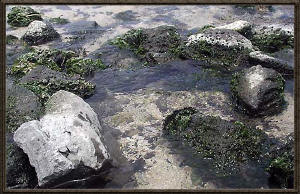|
Invasive Algae Home Red Algae Green Algae Brown Algae Seagrasses Glossary |
|
|||||||||
|
|||||||||
|
Click on pictures for larger
images
Ulva fasciata, also known as limu palahalaha and sea lettuce, is a common green alga that is used for consumption in many parts of the world. High nutrients and fresh water are often indicated by its presence.
Ulva fasciata in a tidepool at O‘ahu. |
|
||||||||
|
Description Thalli thin, sheet-like, consisting of wide blades, 10 - 15 cm wide at base, tapering upward to less that 2.5 cm wide at tip. Up to 1 meter long. Basally broadened, but upper portions divided deeply into many ribbon like segments; margins smooth, often undulate. Holdfast is small without dark rhizoids. Bright grass green to dark green, gold at margins when reproductive. May be colorless when stressed.
U. rigida is similar but has tough dark rhizoids, smaller, more rectangular cells, and separates easily into two sheets.
Structural Features Thalli with expanded blades two cells thick; parenchymatous: cell division may occur anywhere on the thallus but always in a plane perpendicular to the thallus surface. Cells usually square, 8-20 µm wide, 14-40 µm long, irregularly arranged and quadrate to slightly elongate anticlinally. Cell walls fibrillar and made up of cellulose.
Habitat Ulva fasciata is commonly found on intertidal rocks, in tidepools, and on reef flats. Often abundant in areas of fresh water runoff high in nutrients such as near the mouth of streams and run-off pipes.
Distribution Hawai‘i: All Hawaiian Islands.Mechanism of Introduction: Indigenous to Hawai‘i. Worldwide: Eastern Atlantic, Caribbean, Indian and Pacific Oceans.
Ecology/Impact Ulva fasciata, or "sea lettuce", is commonly found in areas where nutrients are high, wave forces low and herbivory reduced. It is tolerant of stressful conditions, and its presence often indicates freshwater input or pollution.
Ulva species are early-successional algae, quickly taking over new substrate on boulders that are cleared by storm disturbance. U. fasciata and Enteromorpha flexuosa are generally the first macroalgae to colonize newly opened substrate in intertidal areas with high nutrients. Their opportunistic success can be attributed to their simple morphologies and fecundity. In Ulva species, between 20 to 60 percent of their overall biomass can be allocated monthly to reproduction. The alga’s reproductive success is partly due to the reproductive cells’ photosynthetic ability. The zoospores’ and gametes’ ability to photosynthesize subsidizes their motility and rapid growth once attached to the substrate. Reproductive cells of U. fasciata have similar photosynthetic rates to adult vegetative cells, with higher respiration rates.
Ecologically successful green alga like U. fasciata are potentially invasive. Coastal waters near harbors, industrial complexes and residential areas with nutrient- rich and/or fresh water input often have blooms of Ulva species that coat ships’ hulls, cover pilings and shorelines, and restrict outflow pipes. U. fasciata is classified as a marine fouling organism, and studies in control and eradication are presently underway.
In Hawai‘i, U. fasciata, or Limu palahalala is a popular seaweed for consumption. Preparation methods include chopped in salads with other limu varieties, boiled in soups, or as a relish. |
|||||||||
|
|
|
|
References Abbott, I.A., 1996. Limu: An ethnobotanical study of some Hawaiian seaweeds. National Tropical Botanical Garden, Lawai, Kaua‘i, Hawai‘i. 4th edition. Beach, K.S., C.M. Smith, T. Michael, and H.W. Shin, 1995. Photosynthesis in reproductive unicells of Ulva fasciata and Enteromorpha flexuosa: implications for ecological success. Mar. Ecol. Prog. Series, 125: 229-237. Littler, D.S. and Mark M., 2000. Caribbean Reef Plants. OffShore Graphics, Washington, D.C. Magruder, W.H. and J.W. Hunt, 1979. Seaweeds of Hawai‘i. Oriental Publishing Company, Honolulu, Hawai‘i. Russell, D. J. and G. H. Balazs, 2000. Identification manual for dietary vegetation of the Hawaiian green turtle, Chelonia mydas. NOAA TM-NMFS-SWFSC-294. 49 pp.
|
Web Pages Introduction to Marine Botany, Stanford University. http://www.mbari.org/~conn/botany/default.htm Hawaiian Reef Algae. http://www.botany.hawaii.edu/reefalgae/ Virtual Herbarium. http://www.botany.hawaii.edu/reefalgae/greenskey.htm
|

